How do you design a transitional bedroom? 7 looks that perfectly blend old and new
Transitional bedroom ideas are an elegant blend of old and new. But what’s the best way to pull off this classic bedroom look?
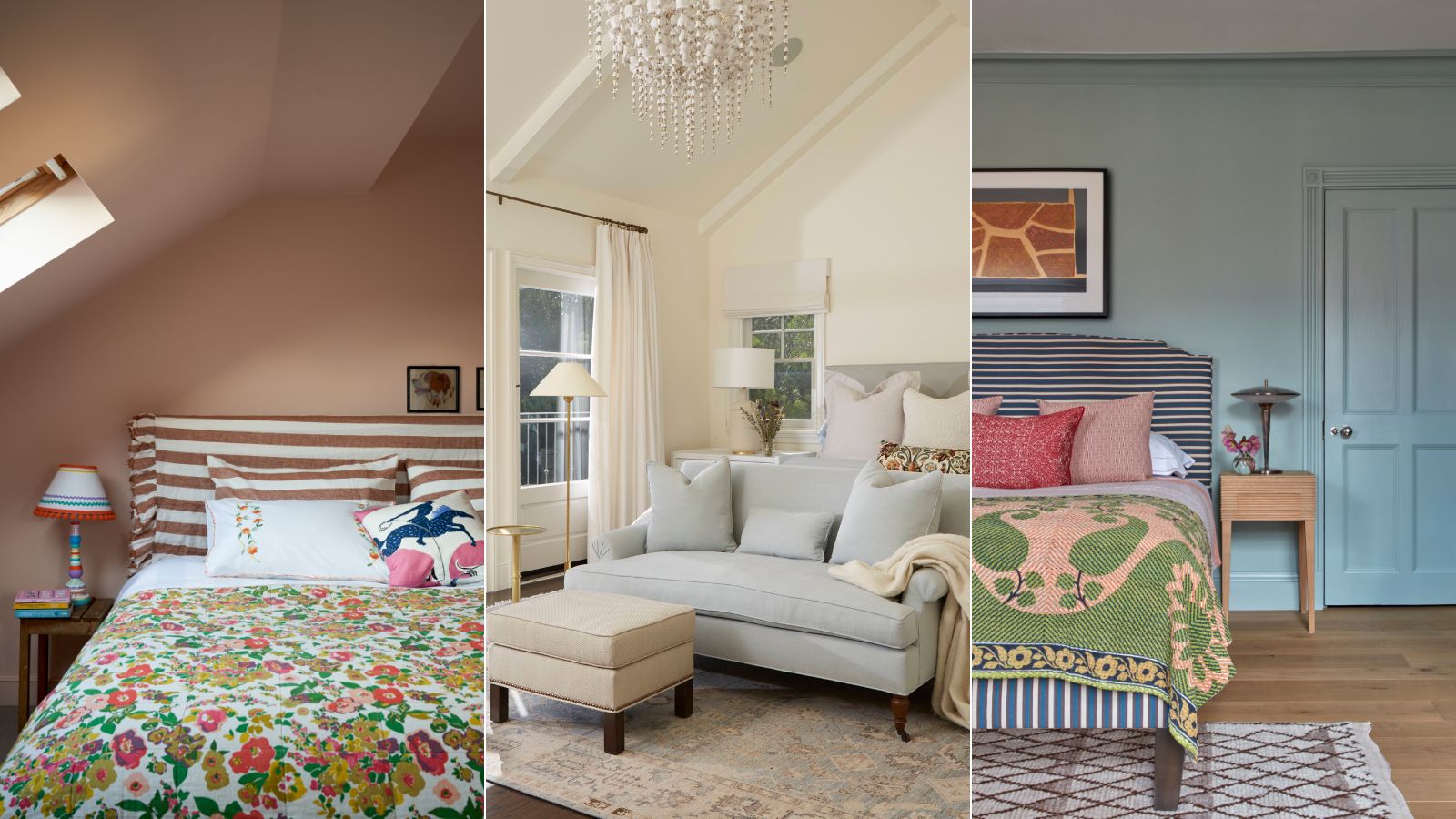

If you want a stylish and timeless sleep space, packed with personality, then transitional bedroom ideas are the answer. Not too modern and not too vintage, everyone is talking about transitional design. And we've seen a huge uptick in designers and homeowners adopting this classic, old-meets-new style for their own.
But what exactly is transitional design and how can you create this eclectic yet harmonious look in the bedroom?
What is a transitional bedroom style?
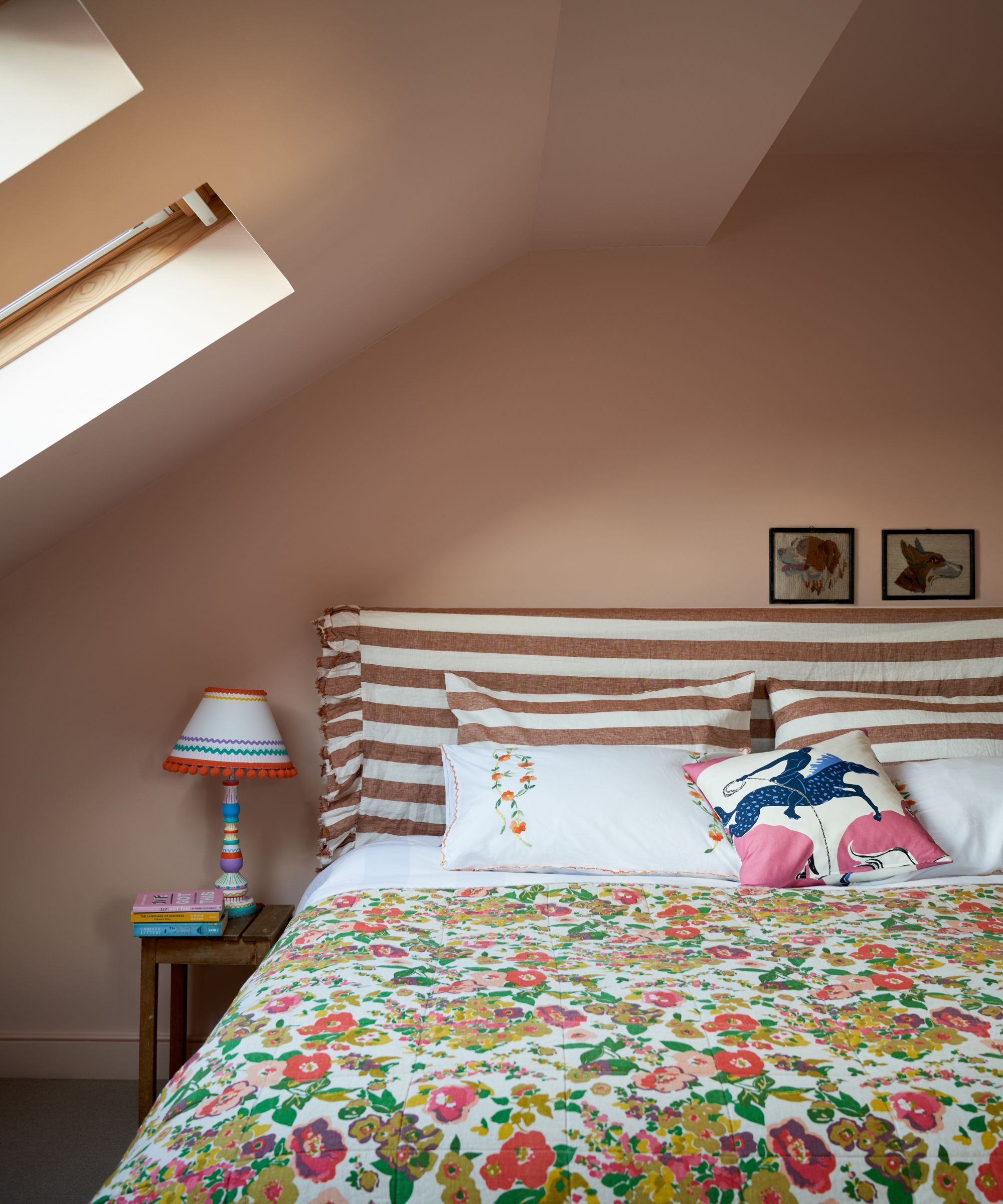
According to the experts, transitional design is perfect for every room in the house. Rather than sticking to a single, micro trend – which can quickly make a home feel dated – transitional interiors are diverse, balanced and timeless. Designers carefully blend contemporary and traditional styles and combine furniture and accessories from a wide range of eras. The result: a classic and individual design mood that can effortlessly adapt to future decorating projects.
'Transitional decorating bridges the decades, styles, and color stories of a home’s architecture and décor to create something unique but also totally appropriate for the space it inhabits,' declares Kentucky-based interior designer Bethany Adams.
In the bedroom, that might mean a four-poster bed but with a clean, unfussy silhouette. Then the classic style can be layered with bold color, handcrafted quilting and fringed velvets, juxtaposed with modern artwork hung on the walls. By blending old and new, modern-day and period, your bedroom will become a considered yet inviting space you’ll never want to leave.
7 transitional bedroom ideas for a timeless look
Transitional bedroom ideas feel timeless but effortlessly current and original. Most importantly, transitional bedrooms are about balancing styles so the room never dates. It’s an effortless look that can take time and skill to create. But the results are definitely worth it, creating a classic mix of styles that won’t date. Rather than following one particular trend, the transitional bedroom is more individual and can reflect your personal décor preferences.
'I’m a firm believer that interior design is a life-long process, and as such, it should reflect your personal taste and changing habits, combining pieces from different eras and styles to really tell your story,' states award-winning British interior designer Matthew Williamson. 'That is what transitional design means to me – combining old and new pieces to create a space that truly reflects your personality.'
Design expertise in your inbox – from inspiring decorating ideas and beautiful celebrity homes to practical gardening advice and shopping round-ups.
Such an edited backdrop of different aesthetics – of old and new – also has another big plus point for the bedroom. It creates a timeless framework so you can freshen up your sleep space should you want to add in some bedroom trends that work for you later on.
1. Go for unexpected bold color

You might assume that a neutral color palette is the number one style mantra for transitional bedrooms, the ultimate blank canvas for such an eclectic mix. Not necessarily so, say the interior design experts.
While there is always a place for top-to-toe neutrals like sand, putty and string, bold color works really well in the transitional bedroom too. Kentucky-based interior designer, Bethany Adams, has vast experience designing and decorating historic homes but always with a dash of modern. And one of the best ways to combine the two is with a bold color backdrop.
In this 1920s Tudor revival property, Adams painted the walls of the principal bedroom in Farrow & Ball’s Hague Blue. It exudes a dramatic yet timeless elegance against the custom-made bed painted in Brinjal. The look is finished off with homespun-style bedding, mismatched pastel lamps and a contemporary Noguchi ceiling lantern, creating the ‘Shaker-Deco’ vibe the client wanted.
'There is a misconception that neutral means gray,' says Bethany. 'This dark navy is a very versatile neutral and can easily be updated through the years as tastes change. Choose a strong neutral and have fun with accent colors – you cannot go wrong.'
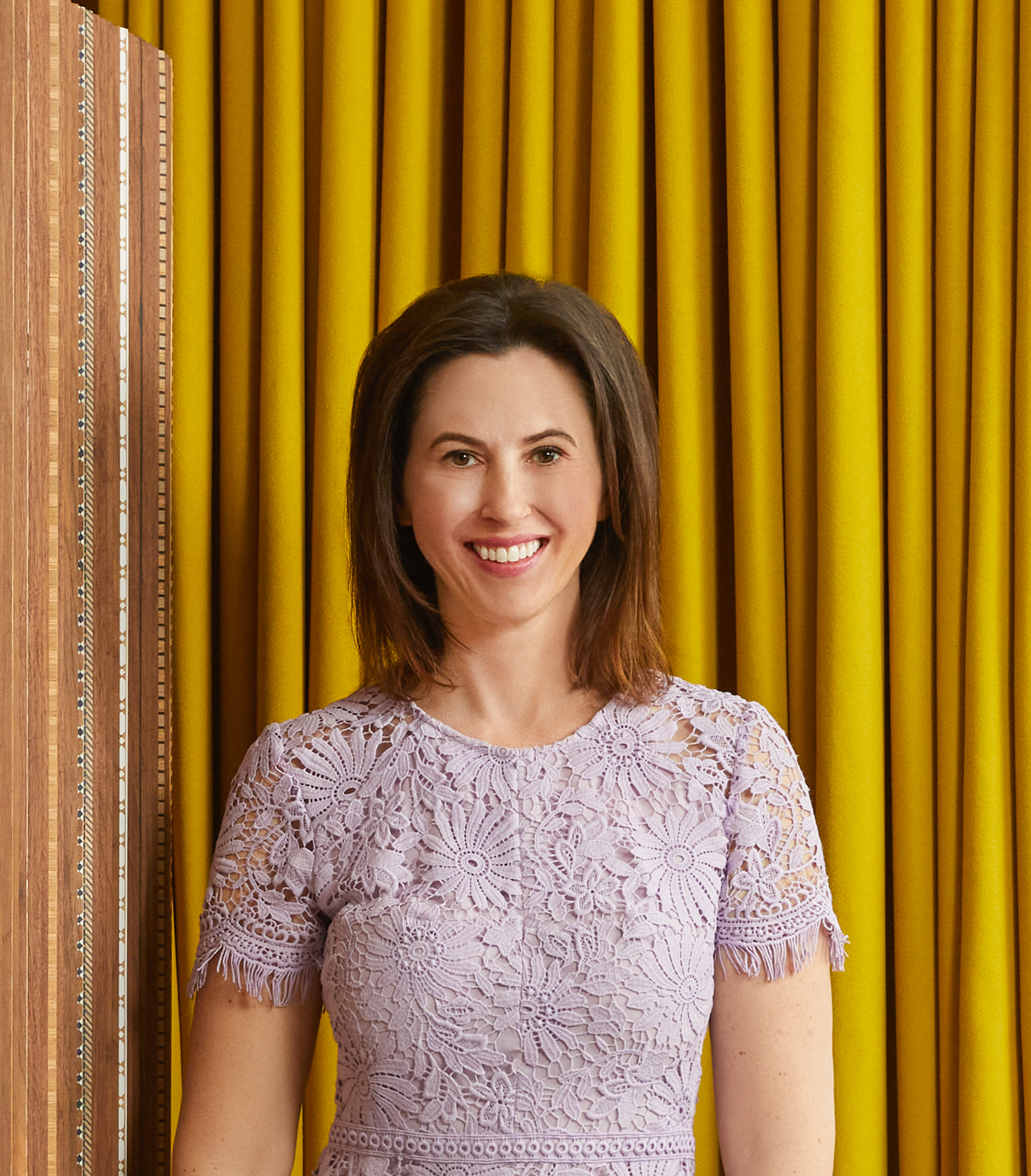
Based in Louisville, Kentucky, Bethany Adams has over 15 years of experience designing and project-managing high-end residential projects. She is a member of ASID (American Society of Interior Designers), AIA (American Institute of Architects and a certified interior designer with the Kentucky Board of Architecture.
2. Choose a focal point in transitional bedrooms
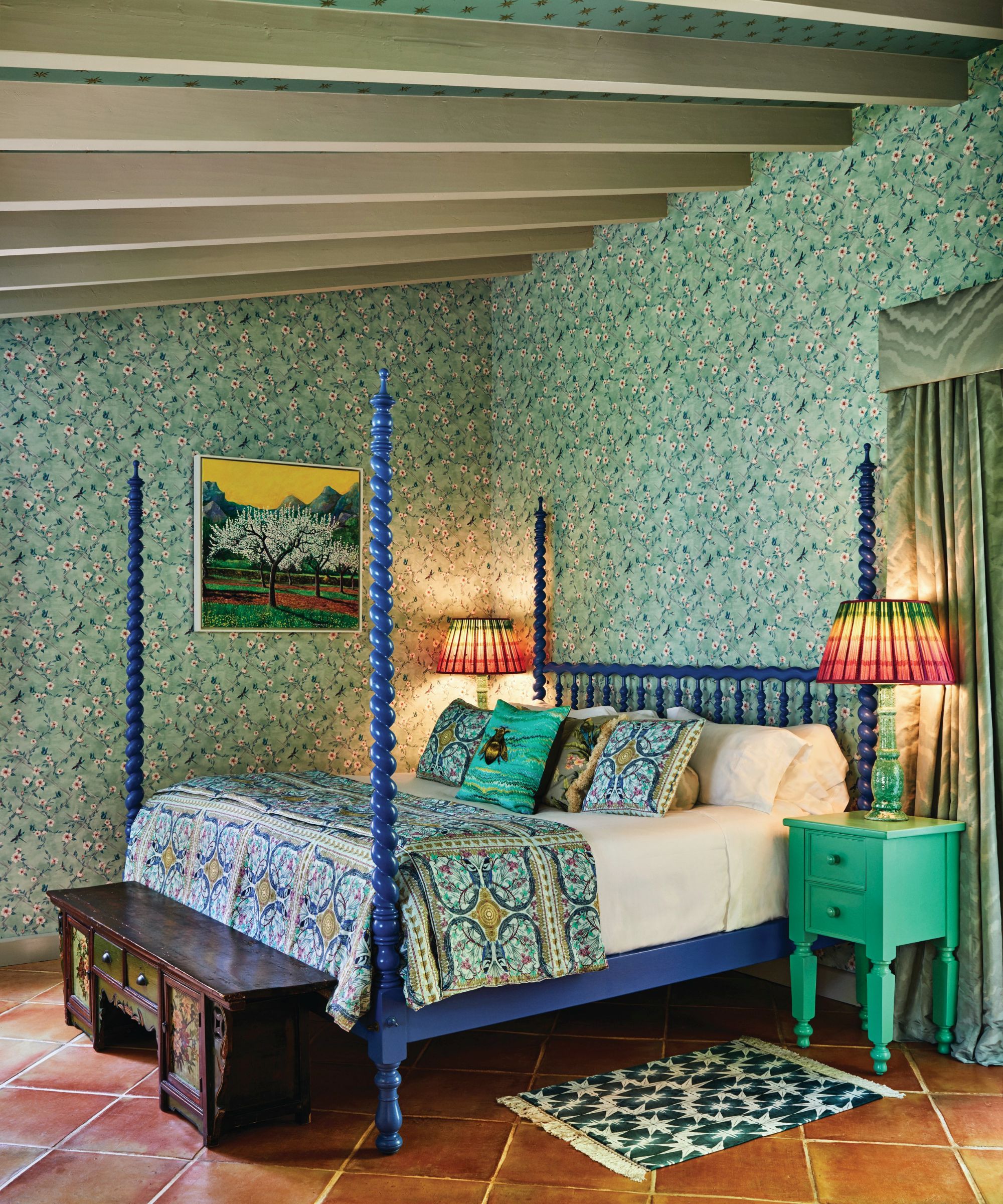
Selecting a focus in transitional bedroom design is a good starting point. Try a print, a pattern or a piece of furniture, something you love, a statement piece you can layer with details.
'For the bedroom, choose a key focus, maybe it’s a vintage-style wallpaper or a traditional four-poster bed, and search for the perfect modern complement which could be a sleek nightstand or a patterned rug,' says British interior designer Matthew Williamson. 'No matter what you go for, never stop searching, always give in to your curiosity and if you love something, bring it home. This may be a slower method of finding what you need, but once you have it, you'll love it forever. Buying less and buying better is the key here.'
In this joyful, colorful bedroom, the beautiful Rosanna Trellis wallpaper – from Williamson’s collection with Osborne & Little – is used to pattern drench the walls. The delicate and ditsy floral print is contrasted with a graphic striped lampshade and tile-inspired bedding. For an extra modern twist, the traditional bed frame is lacquered in a bold Yves Klein electric blue.

Matthew Williamson is an award-winning British interior designer who began his illustrious career in fashion under his namesake brand. Known for his unique use of pattern and color, Williamson has drawn on his decades of experience and pivoted seamlessly into the world of interior design. He has several homeware collections as well as a growing residential and commercial interior design business.
3. Embrace cleaner lines

Transitional bedroom décor is about balance. It’s neither too modern nor too traditional. The key is to pitch the look somewhere in the middle by introducing cleaner lines and bedroom furniture with a pared-back silhouette. It’s a premise that Texas-based interior designer Kim Armstrong swears by in her work.
'You don’t have the ornateness of more traditional bedroom furniture, but you don’t have the modern styling of uber-modern furniture either. It’s like you take a traditional style and just straighten up the lines a bit,' she explains.
The middle-ground aesthetic also extends to pattern choice too. 'For instance, in a rug, you might have some of the shapes of a traditional oriental, but the pattern is larger, the color palette feels fresher, which moves the design into a more modern direction.'
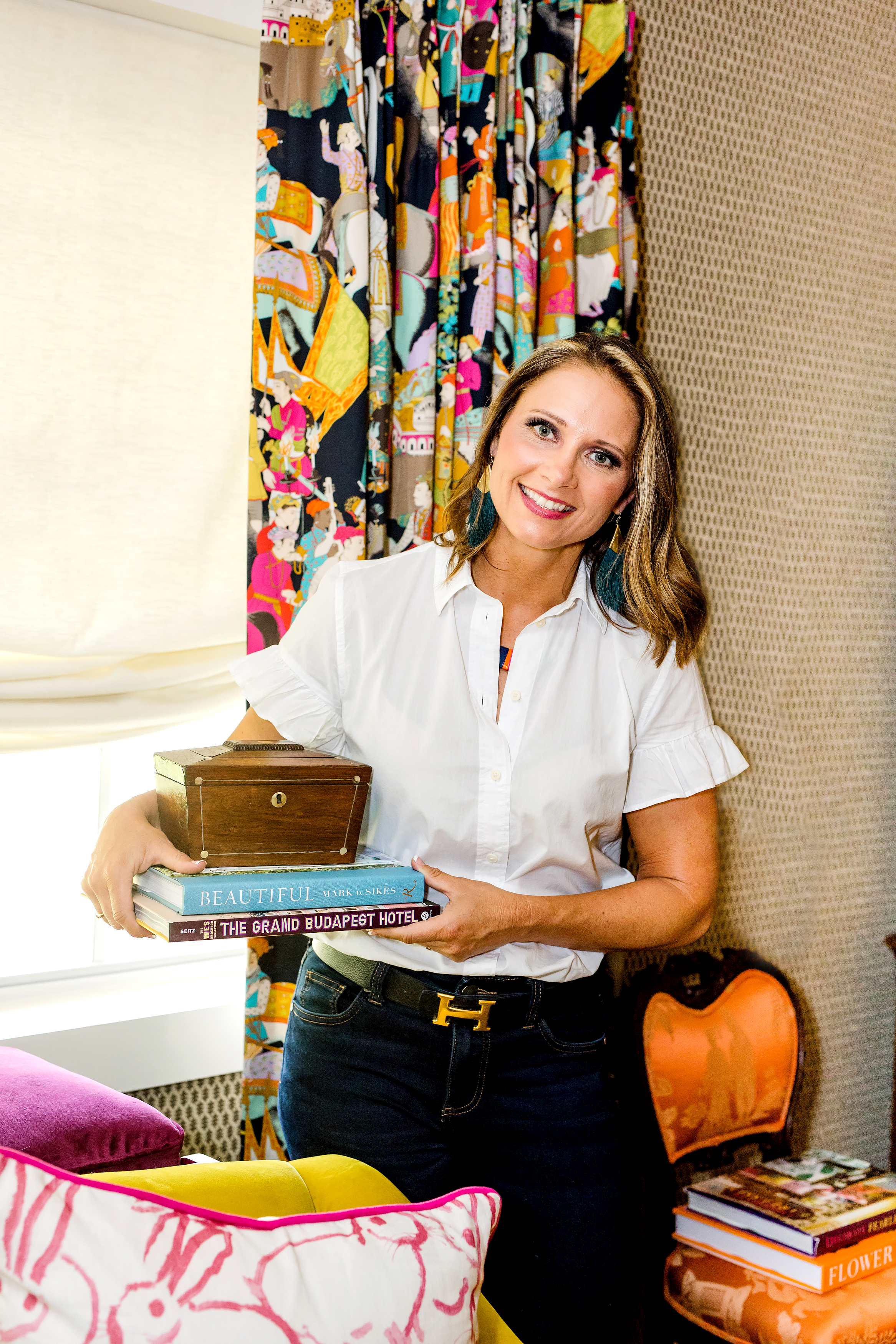
Kim Armstrong is a leading designer who is renowned for her colorful, eclectic, livable and luxury spaces. She heads up her boutique design firm and serves clients in North Texas and beyond with her colorful, eclectic designs.
4. Add texture for a cozy bedroom ambience

Creating comfortable surroundings with fabric and texture is a key aesthetic of transitional bedroom design. Think upholstered headboards, antique rugs, textured linens, even a hint of cashmere. This quintessential, transitional bedroom is a showcase of cozy, feel-good fabrics mixed with classic silhouettes and bold bedroom wallpaper.
'This design philosophy is not just about the physical elements but also about invoking a serene and timeless ambiance, appealing to those who seek a refuge from the ever-changing world outside,' declares New York-based interior designer Kati Curtis. 'The property is in the West Village, New York, and is a second home for the couple, who reside in Palm Springs full time. They wanted a ‘cozy’ home in NYC that was reflective of their modern tastes while respecting the Victorian roots of the home.'
The layering of texture and decorating with pattern is pivotal: a rich blend of emerald velvet on the headboard, faux fur cushions, and a bold botanical print wallpaper in vintage gold and green. That’s not forgetting the original tin ceiling to maximize the cocoon-like space Kati wanted to achieve.
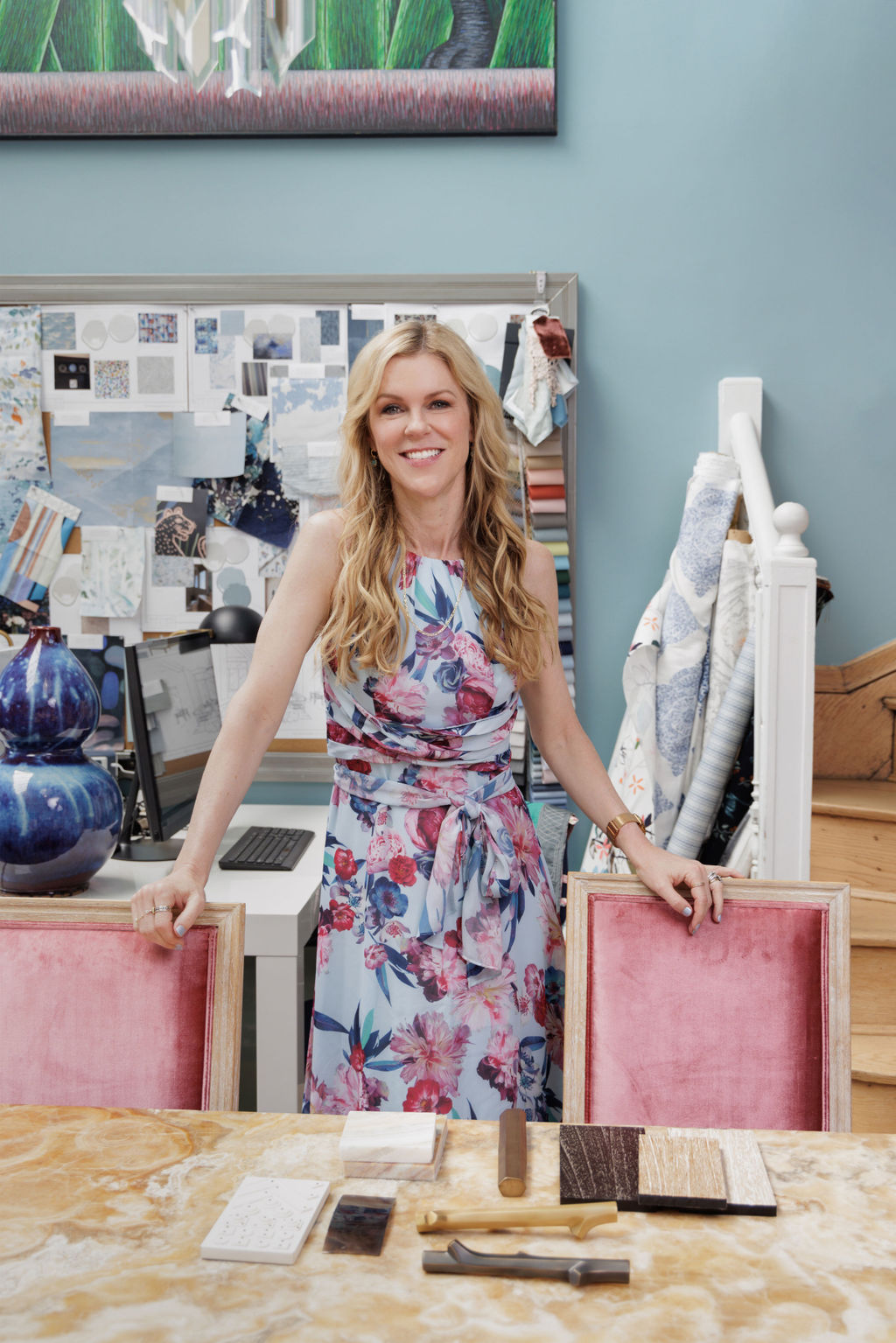
Kati Curtis is the creative force behind Kati Curtis Design, a full-service interior design firm known for its distinctive blend of modern and traditional aesthetics. With a keen eye for color and an eclectic approach to design, she infuses classic styles with a global perspective. Curtis is dedicated to bringing sophisticated, sustainable, and culturally rich interiors to discerning clients worldwide.
5. Nail neutrals in transitional décor

'When it comes to bedroom color palettes, we often favor blending neutral and subtle tones to create a serene backdrop,' explains Rebecca Larn, associate director of global interior design and architecture studio, Elicyon. 'This allows for diverse design elements to coexist harmoniously.'
This cool, calm and collected bedroom, by California-based interior designer, Lucie Ayres of 22 Interiors, certainly shows off all the benefits of a neutral palette if you’re not into color.
'Transitional style in design is like a stylish friend who can seamlessly mix modern and vintage clothing and accessories,' says Lucie 'Neutrals are often the modern element. Pale shades of blues and greens, mixed with cream, beige and white have a calming effect on the eye and therefore skew more modern. These understated hues are unlike many traditional prints that tend to be saturated with color.'
'So, if you mix a colorful antique rug, tone it down with a neutral fabric like we did with this bed and sofa, and create a true transitional moment.'
6. Be playful with print
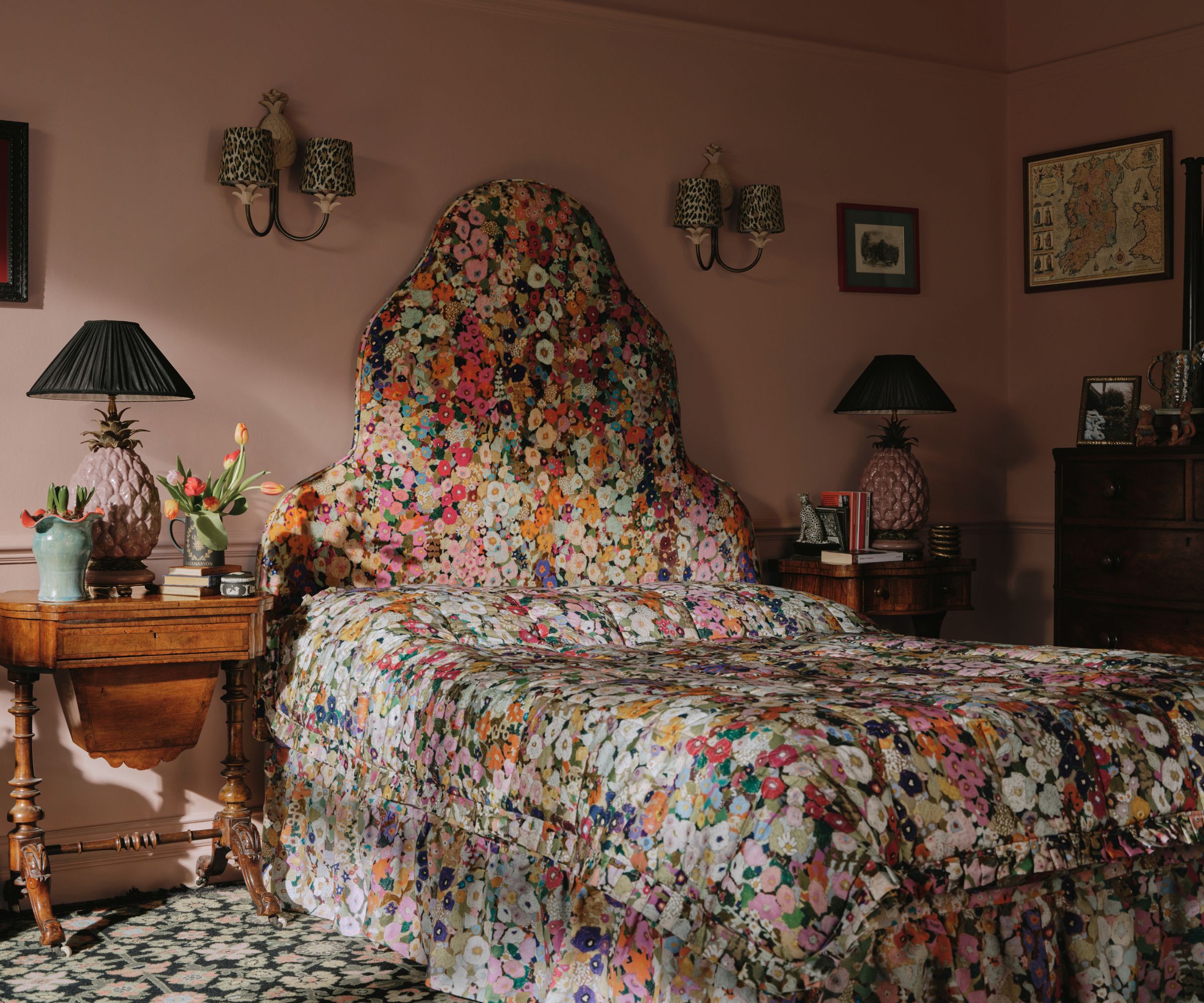
Transitional bedrooms certainly honor the period features of a property. But the most successful schemes add a modern twist. One way to do this, is with a playful use of fabric.
In this guest bedroom by House of Hackney, the gorgeous Hollyhocks fabric is used to pattern drench the bed. This exaggerated use of print transforms an uninspiring space into an eye-catching room your guests will never want to leave!
'Be playful with print, whether that’s investing in a statement headboard or giving a beloved family heirloom some love,' explains Chloe Vince, decorating consultant at House of Hackney. 'Hollyhocks is the perfect print to refresh any scheme and will give you that wow factor for a guest room. Although it is fun, it's also very restful and a great way to bring the outside in.'
7. Clash color and pattern with confidence
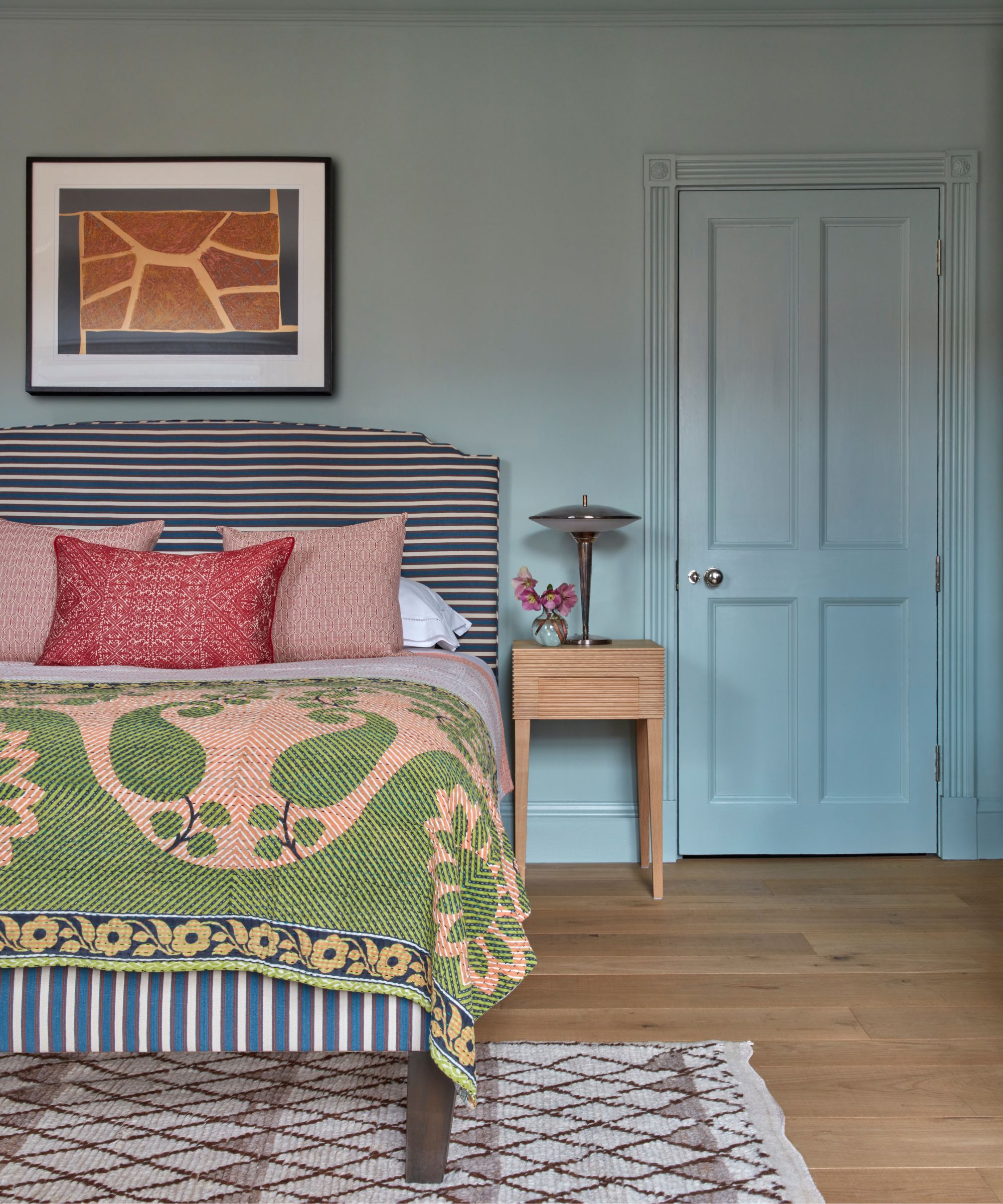
The best transitional bedrooms are a mix and match of color, pattern, and furniture. However, such an eclectic mood rarely happens all at once. So, the advice from the design experts is to take your time.
'We love layering different colors, patterns, and furnishings,' says London-based interior designer Kate Guinness. 'Mixing different patterns and prints in a room is a fine balance though, so we would advise not to rush it. While it can feel nice to have everything decided in one go, we tend to approach room schemes as a series of layers to be built up.'
It can take a skilled design eye to put together such diverse styles and hues and come up with an effortlessly cool and harmonious look. But one takeaway tip from Kate is to invest in a good bedroom rug. 'We tend to use a lot of vintage rugs and often slot these in once the basic scheme is in place. But there is no right or wrong way to do this. Many designers start with a rug and build up a room the opposite way around.'
The best places to shop vintage online will have hundreds of options to choose from depending on the color and style you are after – try 1stDibs, Chairish and Etsy.
Transitional bedrooms are the perfect approach if you want to design a home that never dates. The mix of old and new and the blending of different interior design styles transcends trends but still allows room to bring in current styles too. Essentially, the key to transitional style is to just decorate in a way you love to create a characterful space that reflects the person within it.

Lara has worked in the ever-changing world of interiors and lifestyle journalism for many years. She cut her teeth in a busy newsroom of a kitchen and bathroom business title where she gained vast product knowledge and industry contacts that would prove invaluable. She now freelances for a variety of magazines, newspapers and online blogs and relishes the changing landscape of the interiors world.